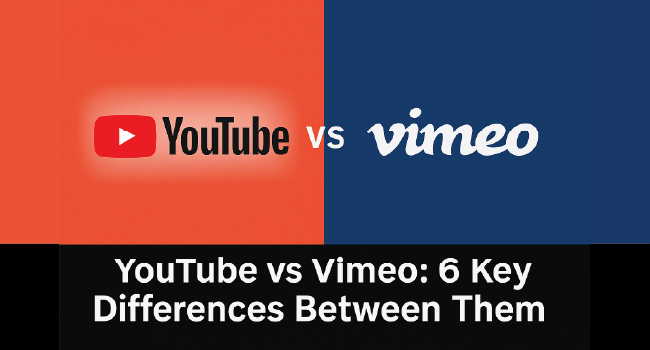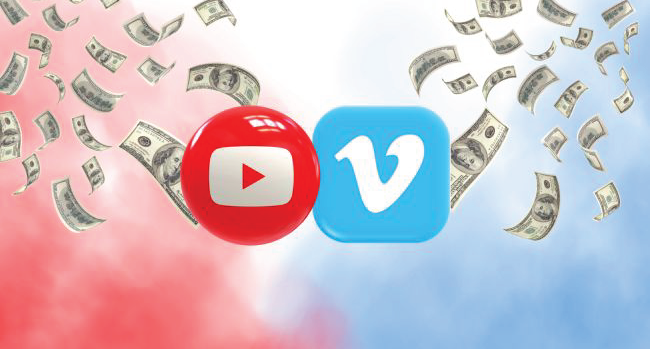YouTube vs Vimeo is one of the first comparisons people make when deciding where to host their videos. Both platforms have grown in different directions, so the right choice depends on what you want to achieve.

If your goal is reaching millions of people and tapping into Google search visibility, YouTube shines. On the other hand, Vimeo has carved a space for creators, businesses, and educators who value clean embeds, stronger privacy, and brand-safe streaming.
YouTube vs Vimeo: Detailed Comparison
To make the right choice, you need to see how each platform performs in real situations. YouTube vs Vimeo can be measured by reach, monetization, privacy, video quality, analytics, pricing, and live streaming. Looking at these areas side by side gives you a clear picture of which one fits your goals best.
Audience Reach and Discovery
When you think about reach, the gap between the two platforms is huge. YouTube has over 2.5 billion active users worldwide, making it the second most-visited website after Google. Videos uploaded here can appear on the platform's homepage, in recommended feeds, or even in Google search results.
YouTube has also changed how it highlights popular videos, the old trending section was replaced by personalized recommendations, so today people often say the YouTube trending page is gone.
This shift matters because discovery now depends more on algorithms and viewing habits than on a single chart of what's hot. That ecosystem gives your content a real chance to be discovered by people who have never heard of you before.
Vimeo plays in a different league. The platform counts tens of millions of users, but most of them are professionals like filmmakers, educators, and businesses looking for polished, ad-free hosting.
Vimeo doesn't push videos through algorithms or search the way YouTube does. Instead, it gives you stronger control over where and how your videos are viewed. For example, you can lock playback to your company's website, embed training content for employees only, or share a password-protected video with a client.
Monetization Options

When it comes to making money, YouTube vs Vimeo comparison shows two very different paths. YouTube has the Partner Program (YPP), which lets you earn from ads once you hit the entry requirements, currently 500 subscribers, 3 valid uploads, and 3,000 watch hours in the past year, or 3 million Shorts views in 90 days.
Once you qualify, you can unlock ads, channel memberships, Super Chats during livestreams, and even revenue from YouTube Premium viewers. For many creators, this program is the first step toward turning content into a career.
Here's where many people get stuck: building those first subscribers and hours can take months of effort. That's exactly why we created a service to help you. With our services, you can buy YouTube Subscribers or buy YouTube Watch Time from real people, delivered fast and securely.
It's the safest way to speed up your growth, meet YouTube's requirements, and unlock monetization without endless waiting. If you're serious about turning your channel into a source of income, this gives you the head start you need.
Vimeo doesn't run ads, so it focuses on direct monetization through its OTT (over-the-top) platform. You can set up a subscription service, rent out videos, or sell access to individual titles.
Privacy and Embedding Controls
Privacy is one of the clearest dividing lines in the YouTube vs Vimeo comparison.
On YouTube, you can choose:
-
Public – anyone can find and watch.
-
Unlisted – only people with the link can view.
-
Private – only accounts you invite can access.
These options are fine for casual sharing, but they have limits. You can't fully control where your video is embedded, and Unlisted links can spread quickly if shared outside your group. Ads and suggested videos can also appear, which might even include your competitors.
On Vimeo, you get far more control:
-
Password protection for client projects or private lessons.
-
Domain-level embed restrictions so your video only works on chosen sites.
-
Ad-free and customizable player that keeps attention on your brand.
-
Team permissions for internal use and collaboration.
-
Engagement analytics even for password-protected videos, so you know if the right people are watching.
This makes Vimeo especially valuable for professionals. A company can build an internal training library, an agency can share client previews securely, and educators can keep lessons limited to paying students. YouTube, in contrast, is better when your main goal is visibility and public reach.
Video Quality and Streaming Performance

When comparing YouTube vs Vimeo, video quality is often a deciding factor.
On YouTube:
-
You can upload videos up to 8K resolution with HDR support.
-
Compression is heavy, so fine details may look softer, especially at 1080p.
-
Playback adapts to internet speed, which helps avoid buffering but can reduce clarity.
-
The platform optimizes for all devices, from smart TVs to mobile phones.
On Vimeo:
You can also upload in 4K and HDR, and Vimeo often applies lighter compression than YouTube.
-
Videos tend to look cleaner, especially in professional embeds.
-
Playback is smooth with adaptive streaming, though bandwidth limits on accounts can affect large audiences.
-
The player design is clean, free of clutter, and customizable to match your brand.
Analytics and Insights
Analytics play a huge role in choosing between Vimeo vs YouTube, because they show how people actually engage with your videos.
On YouTube:
-
Inside YouTube Studio, you get detailed data for free.
-
Metrics include impressions, click-through rates, watch time, and audience retention.
-
You can see traffic sources, demographics, and even "key moments" where viewers drop off.
-
If you're in the Partner Program, revenue analytics help you track ad earnings, memberships, and Super Chats.
-
Real-time reporting lets you quickly see how new uploads perform.
-
Benchmarking tools allow you to compare your channel's results against others in your niche.
On Vimeo:
-
Advanced analytics are available on paid plans.
-
Engagement heatmaps highlight exactly where viewers paused, rewatched, or dropped off.
-
Reports include viewer location, devices, and playback sources.
-
For OTT businesses, you can track subscriber activity and revenue per video.
-
You can export reports (CSV and more) for sharing with clients or further analysis.
-
Integrations with tools like Google Analytics and HubSpot connect video performance with your wider marketing funnel.
Pricing and Bandwidth Limits
Cost is another area where YouTube vs Vimeo shows clear differences.
On YouTube:
-
Hosting is completely free.
-
You don't have to worry about bandwidth or storage limits.
-
The trade-off is ads, unless you disable them on your own videos or the viewer pays for YouTube Premium.
-
YouTube makes money from advertising, so creators essentially "pay" by sharing revenue or giving up ad control.
On Vimeo:
-
Vimeo runs on a subscription model, starting with basic plans and going up to advanced business tiers.
-
Accounts have a monthly bandwidth limit, usually around 2 TB for self-serve plans.
-
Paid tiers unlock features like advanced analytics, domain-level privacy, and OTT monetization.
-
Pricing makes sense for businesses, but it can be a hurdle for casual creators who just want to upload freely.
YouTube is the clear winner for free, unlimited hosting. Vimeo is better when you're willing to pay for extra control, ad-free viewing, and professional features. For large-scale streaming or branded video libraries, the investment in Vimeo often pays off.
Live Streaming and Events
Live video is where YouTube vs Vimeo shows two very different approaches.
On YouTube:
-
Anyone can go live for free once their account is verified.
-
Live streams can be monetized through ads, Super Chats, Super Stickers, and memberships.
-
Streams benefit from YouTube's massive audience, with events discoverable in search and recommended feeds.
-
Features like live chat and automatic archiving make it simple to engage and repurpose content.
On Vimeo:
Live streaming is part of Vimeo's paid plans.
-
You get advanced tools like event registration, Q&A modules, and branding controls.
-
Streams can be locked to a domain or protected with a password.
-
Enterprise clients can use eCDN (enterprise content delivery networks) to handle large-scale internal events without clogging company bandwidth.
Pros and Cons Summary

After breaking down the features one by one, it helps to see the big picture in a single view. The table below highlights the main advantages and drawbacks of YouTube vs Vimeo side by side. By scanning it, you'll quickly spot which platform aligns better with your goals.
| Feature | YouTube | Vimeo |
|---|---|---|
| Cost & Hosting | Free hosting, no bandwidth limits | Paid plans, ~2 TB/month bandwidth cap |
| Audience Reach | Billions of active users, strong discovery | Smaller, professional user base |
| Monetization | Ads, memberships, Super Chats, Premium revenue | Subscriptions, rentals, pay-per-view (OTT) |
| Privacy & Embeds | Public, Unlisted, Private; limited embed control | Passwords, domain locks, team permissions |
| Player Experience | Ads and suggested videos may distract | Ad-free, customizable player |
| Video Quality | Up to 8K HDR, but heavy compression | 4K+ HDR with lighter compression |
| Analytics | Free, real-time insights with benchmarking | Advanced heatmaps, exports, marketing integrations |
| Live Streaming | Free, scalable, monetizable with fan tools | Paid, secure, event-focused with eCDN support |
| SEO & Discovery | Ranks in Google Search, algorithmic recommendations | Limited SEO visibility, little organic discovery |
| Integrations | Tight link with Google Ads, Google ecosystem | Connects with HubSpot, Google Analytics, CRM tools |
Conclusion
When choosing a video platform, comparing YouTube vs Vimeo helps you see which one matches your goals. YouTube is the go-to choice if you want global reach, fast growth, and monetization options at scale.
It’s built for creators who aim to grow an audience and turn content into income. Vimeo focuses more on control, presentation, and privacy. That makes it ideal for businesses, educators, or anyone who needs clean embeds, ad-free streaming, and secure video delivery.
FAQs | Frequently Asked Questions |
Can I upload the same video to both YouTube and Vimeo?
Yes, you can. Many creators publish the same video on YouTube for reach and on Vimeo for professional embedding. Just keep in mind that engagement won’t transfer between the platforms.
Which platform is better for hosting client work?
Vimeo is usually better for client projects because you can add passwords, restrict embeds, and customize the player. That makes it easier to share work privately and securely.
Does Vimeo allow ads like YouTube?
No, Vimeo doesn’t run ads on videos. Instead, it relies on subscriptions and OTT features for monetization. That’s why it’s often chosen for ad-free, professional environments.
Can I stream in 4K on both platforms?
Yes, both YouTube and Vimeo support 4K streaming. YouTube goes as high as 8K HDR, while Vimeo keeps compression lighter, which often results in a cleaner look for professional uploads.
Is one platform better for SEO?
YouTube has the edge for SEO because videos rank in both YouTube search and Google search results. Vimeo videos don’t appear as prominently, making it less effective if discovery is your goal.
